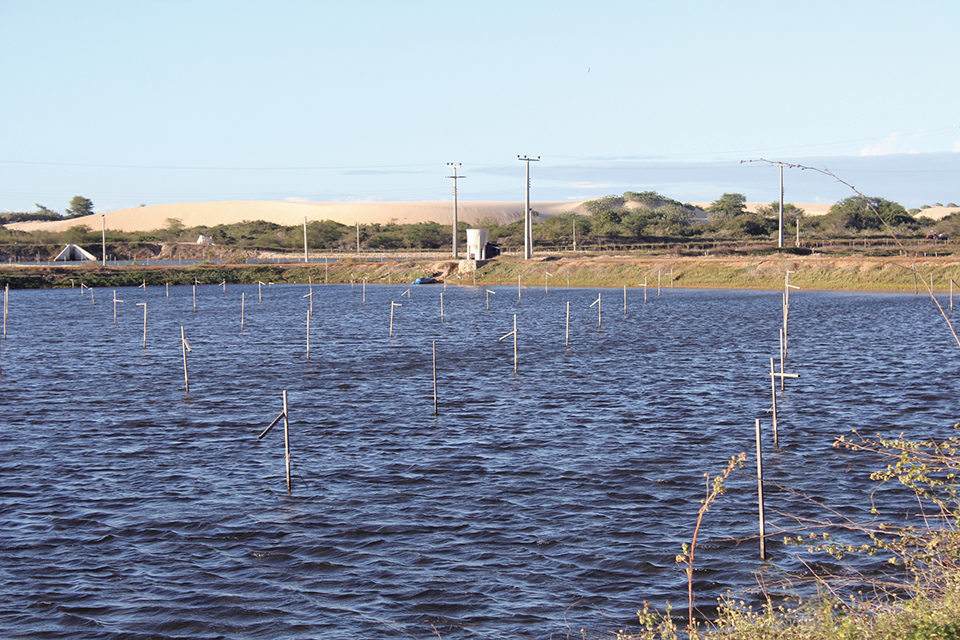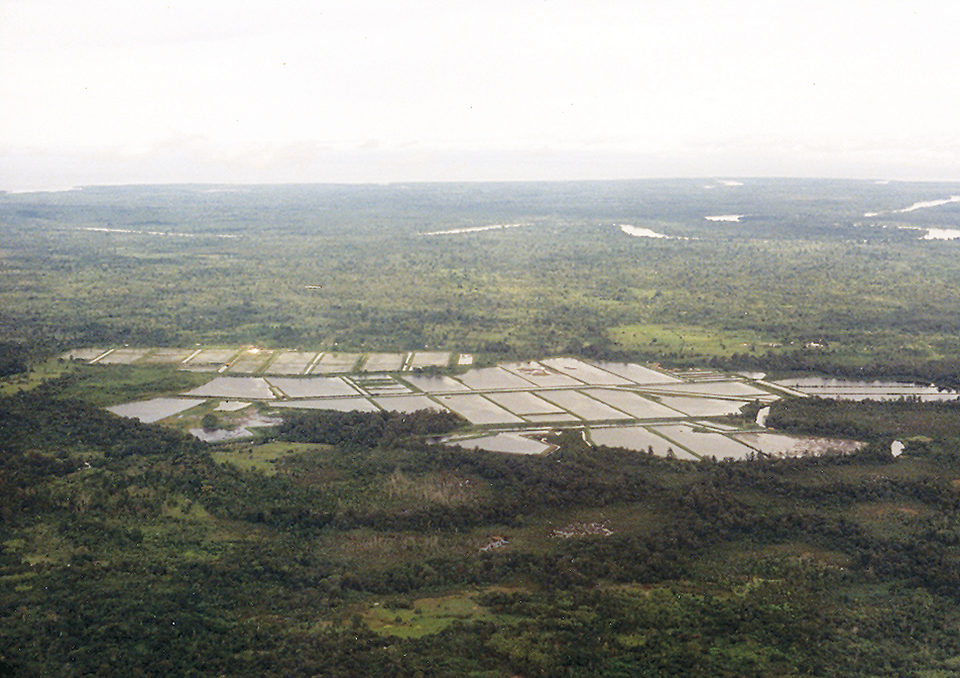Pathogen is readily spread through the water by myriad vectors

A number of commonalities have been observed among occurrences of early mortality syndrome (EMS) or acute hepatopancreatic necrosis (AHPN) in shrimp in Southeast Asia and Mexico, where its presence was only recently confirmed after affecting the aquaculture industry for months. These observations provide clues as to what is going on and point to potential approaches for dealing with the disease.
Disease factors
It has been noted that when shrimp are reared in cages off pond bottoms in ponds where shrimp are dying from AHPN, they are unaffected. It has also been noted that when animals are held in nursery raceways – even with the same water used in ponds – they do not typically develop the disease. This suggests AHPN is not transmitted through the water column. This could be for a number of reasons, although the most logical is that the virulent strain of Vibrio parahaemolyticus bacteria that causes AHPN never reaches high enough levels to be infective via the water column.
Bacterial loads in ponds vary considerably. Ponds develop very complex ecosystems with many species of bacteria, algae, phytoplankton and zooplankton. Vibrios are always present at some level, although even in the middle of outbreaks from obligate pathogens, the levels are not typically very high. Attachment of this pathogenic Vibrios to various substrates could readily explain transmission.
Since there is no evidence that this bacteria causes septicemia, it is highly likely that molting disrupts the biofilm process. Given that it takes time for the bacteria to progress through the various stages of biofilm formation, this explains why we do not see the disease in hatcheries.
Strains of V. parahaemolyticus are ubiquitous, so it is not surprising to find them in hatcheries, production tanks, Artemia and algal production systems, as well. No one has reported mortality in broodstock held in nuclear breeding facilities, although there is no reason why, if the pathogen were present in larger animals, it could not kill them.
Another interesting observation from the field is that co-cultivating shrimp with tilapia seems to lessen the incidence and severity of the disease. It is common knowledge that tilapia produce substances that inhibit a variety of bacteria, including Vibrios. This is one of the attractive features of greenwater culture. The exact nature of these materials remains to be elucidated, and while there are theories, it seems this is not an absolute effect. Some farms still report problems when they co-cultivate with tilapia.
Additional observations show that farms that use well water in some ponds and seawater in other ponds only have the disease in the ponds with non-well water. This further supports the theory that the primary mechanism of movement of the pathogen is not between shrimp but through a host of vectors similar to what we see in cholera. Furthermore, the incidence of the disease in farms that use water with less than 5-ppt salinity is much lower than in those with higher salinities. In that Vibrio parahaemolyticus strains do not typically grow in water that is less than about 1 percent sodium chloride (10 ppt), this is expected.
Toxins
The role of a toxin-producing gene is of paramount importance, so determining the nature of the toxin and how its production can be controlled could be important in minimizing its impacts. Many toxins have been identified in association with V. parahaemolyticus , and it is probable that the toxin that is damaging the hepatopancreas tissue of shrimp is not something new.
Toxins are often produced as the result of a phenomenon known as quorum sensing. Simply put, this is a means by which bacteria communicate with each other. Toxins are common substances involved in the nutrition of bacteria. The fact that they are toxic to specific hosts is not their primary function. It is a side effect of their presence.
Producing shrimp in stressful environments and using pseudoscientific culture practices can play roles in the spread of the disease. The evidence suggests that many widely marketed probiotics have little if any impact on the loads of Vibrios in the environment. Eliminating the bacteria is impractical, although one can develop strategies that favor the growth of generally more benign yellow Vibrios over the more problematic green Vibrios. Addressing the presence of potential vectors could also lessen impacts.
Farm controls, treatments
What options do farmers have? At this time, they are limited.
Some claim the AHPN problem comes from broodstock and hatcheries. Shrimp molt daily in hatcheries, making the development of a stable biofilm problematic. While there is no doubt that V. parahaemolyticus strains are present in broodstock and throughout poorly managed hatcheries, given their ubiquitous nature and strong evidence that the etiologic agent of AHPN is moved by vectors, it is not likely the source of the disease is broodstock or hatcheries.
Farms should apply biosecurity, of course. Precautions should always be taken to lessen the loads of potential pathogens, and the technology to do this is well established. Certainly, considering the similarity to V. cholerae, it makes sense that controlling ingestion of materials that contain the bacteria, whether detritus on pond bottoms, zooplankton or algae, becomes part of an apparent solution.
Ideally, farmers need to create conditions that make it harder for the Vibrio to colonize the animals’ stomach and for the toxin to produce its pathology. Theoretically, this can be done by changing the production paradigm and eliminating the niches the bacteria occupies, or making it more difficult for shrimp to ingest high loads of the bacteria. One possible approach might be to use higher water-exchange rates to flush out nutrients and bacteria.
Blocking attachment of the bacteria to the stomach wall and gastric mill warrants a closer look, as does the use of compounds that kill the bacteria as they enter the host or even during the early stages of attachment. Likely a combination of several approaches might prove useful.
One approach might be to feed the shrimp compounds that inhibit the bacterial growth. These would include antibiotics, monoglycerides and a host of other substances that are potentially inhibitory. However, if the biofilm is typical of that noted in other bacteria, the AHPN Vibrio will be protected by the biofilm. Timing of delivery would be critical and problematic.
Out of balance
There is much speculation about where AHPN originated and in what reservoirs it resides in the environment. Shrimp farming by its very nature encourages the growth of Vibrios. They are present naturally in all environments, and there are complex mechanisms in place that typically moderate them. The balance for V. parahaemolyticus has been disturbed, and this could explain why the bacterium is able to proliferate at the expense of others.
The widespread use of chlorination to eliminate white spot syndrome virus and other vectors that might be present in incoming water may be a contributing factor, since this alters ponds’ microbial ecology. It is well documented that chlorine increases the ease with which organic matter is assimilated, and there are reports that this may stimulate bacteria that form biofilms.
The irony in this is that the use of chlorine is not the most effective approach to control viral loads. The role of secondary bacterial infections in animals weakened by the virus may be more important in determining the outcome of the disease process than the presence of the virus itself.
Some vectors produce cysts that are buried deep in sediments. Within a few weeks post-chlorination, the virus is easy to find in vectors and the environment again. Whether active disease ensues is environment-dependent.

Exclusion + management
The preponderance of evidence to date suggests that exclusion where possible and appropriate management of ecosystems might offer some hope in addressing AHPN. Yet the “shotgun” approach some producers are using toward the disease – dumping anything they can get their hands on into ponds and the shrimp, as well – does not allow ready determination of what methods are successful in limiting the disease process.
It is clear is that the problem is likely moved through many different vectors in the water, and that shrimp’s consumption of the bacteria plays a critical role in the disease process. Not all exposed shrimp are universally affected. Some die, while others grow poorly and have poor feed conversion or other symptoms, but don’t die.
The manipulation of a complex aquatic ecosystem along with a foolish production practice likely allowed the AHPN Vibrio bacteria to dominate in a few ponds. From there, it readily spread, much as cholera has and will again. However, unlike cholera, AHPN appears chronic. As long as animals are recolonized with this particular pathogen, the problem will persist.
Perspectives
To conclude, there are many analogies between the etiologic agents of AHPN and V. cholerae. Unwise culture practices could have led to the initial transfer of genetic material that allowed a strain with these particular properties to develop and propagate. The pathogen is readily spread through the water by myriad vectors. The pathogen has been able to establish itself and will likely continue to spread.
It is not likely that genetic selection will allow the development of shrimp that tolerate the toxin, and since it binds to chitinous surfaces, this will not likely change. Controlling the pathogen will require a combination of environmental manipulation techniques that allow balance to be restored, changing the production paradigm in areas where the problem is endemic and balance cannot be restored. Tools that lessen the overall load of Vibrios at all stages of the shrimp production process might be useful in reducing the impacts of AHPN, ultimately allowing an ecological shift back to a more favorable outcome.
In that this bacterial pathogen is unlike anything reported in shrimp farming to date, many of the classic strategies for controlling bacteria are not likely to work. In the long run, the process of elimination will winnow out marginal farms and those farmers who consistently fail to use the tools of proactive disease management and science to ensure they produce sustainable and consistent crops. The end result will be a more robust and healthier shrimp-farming industry.
Editor’s Note: This article is based on a longer paper by the author. To read the full text, visit www.sustainablegreenaquaculture.com/uploads/5/3/7/2/5372499/what_can_shrimp_farmers_do_about_ems.pdf.
(Editor’s Note: This article was originally published in the January/February 2014 print edition of the Global Aquaculture Advocate.)
Author
-
Stephen G. Newman, Ph.D.
6722 162nd Place Southwest
Lynnwood, Washington 98037-2716 USA
Tagged With
Related Posts

Health & Welfare
Development of 1-monoglycerides against AHPND
1-monoglycerides are known for their antibacterial and antiviral effects in the human pharmaceutical and animal husbandry industries. As a substitution for the preventive use of antibiotics, these molecules are being evaluated in the fight against AHPND.

Health & Welfare
Four AHPND strains identified on Latin American shrimp farms
Two virulence genes are known to encode a binary photorhabdus insect-related toxin that causes acute hepatopancreatic necrosis disease in shrimp. The pathogenicities of these V. campbellii strains were evaluated through laboratory infection and subsequent histological examination in P. vannamei shrimp.

Intelligence
As ocean temperatures rise, so too will vibrio outbreaks
A study using a half-century of data has linked climate change and warming sea temperatures with an increase in illnesses from the common vibrio bacteria. Shellfish growers, fighting a particularly virulent strain of Vibrio parahaemolyticus, are changing their harvest protocols.

Health & Welfare
Caveat emptor when seeking for EMS solutions
The development of polymerase chain reaction testing to detect the bacteria that cause EMS is important, but confirmation by bioassay of presumptive positives to ensure pathogenicity is a prudent intermediate step.


